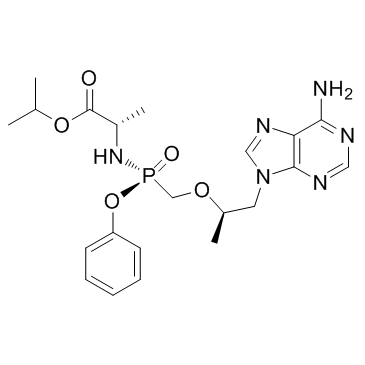147127-20-6
| Name | Tenofovir |
|---|---|
| Synonyms |
(R)-(((1-(6-Amino-9H-purin-9-yl)propan-2-yl)oxy)methyl)phosphonic acid
(R)-(1-(6-amino-9H-purin-9-yl)propan-2-yloxy)methylphosphonic acid D,L-TENOFOVIR Apropovir 9-Pmpa MFCD07357269 Tenefovir GS-1278 1-(6-Aminopurin-9-yl)propan-2-yloxymethylphosphonic acid |
| Description | Tenofovir is a nucleotide reverse transcriptase inhibitor to treat HIV and chronic Hepatitis B. |
|---|---|
| Related Catalog | |
| In Vitro | Tenofovir shows cytotoxic effects on cell viability in HK-2 cells, with IC50 values of 9.21 and 2.77 μM at 48 and 72 h in MTT assay, respectively. Tenofovir diminishes ATP levels in HK-2 cells. Tenofovir (3.0 to 28.8 μM) increases oxidative stress and protein carbonylation in HK-2 cells. Furthermore, Tenofovir induces apoptosis in HK-2 cells, and that apoptosis is induced via mitochondrial damage[1]. Tenofovir and M48U1 formulated in 0.25% HEC each inhibits the replication of both R5-tropic HIV-1BaL and X4-tropic HIV-1IIIb in activated PBMCs, and inhibits several laboratory strains and patient-derived HIV-1 isolates. The combined formulation of M48U1 and tenofovir in 0.25% HEC exhibits synergistic antiretroviral activity against infection with R5-tropic HIV-1BaL, and is not toxic to PBMCs[2]. |
| In Vivo | Tenofovir Disoproxil Fumarate (20, 50, 140, or 300 mg/kg) administered to BLT mice, shows dose dependent activity during vaginal HIV challenge in BLT humanized mice. Tenofovir Disoproxil Fumarate (50, 140, 300 mg/kg) significantly reduces HIV transmission in BLT mice[3]. Tenofovir Disoproxil Fumarate (0.5, 1.5, or 5.0 mg/kg/day, p.o.) induces a dose-dependent decline in serum viremia in woodchucks chronically infected with WHV. Tenofovir Disoproxil Fumarate administration is safe and effective in the woodchuck model of chronic HBV infection[4]. |
| Cell Assay | Cells are plated into 48-well tissue culture plates (39,000 cells/mL) and allowed to grow for 48 h followed by treatment with vehicle or Tenofovir. Following the treatment period, cell viability is assessed using the MTT assay. The MTT assay relies on the conversion of tetrazolium dye 3-(4,5-dimethlthiazol-2-yl)-2,5-diphenyltetrazolium bromide (MTT) to formazan by NAD(P)H-dependent oxidoreductases[1]. |
| Animal Admin | Twenty adult chronic WHV carrier woodchucks are stratified equally by age, sex, body weight, and serum GGT activity into five treatment groups consisting of four animals each: (i) Tenofovir Disoproxil Fumarate at 15.0 mg/kg once per day, (ii) Tenofovir Disoproxil Fumarate at 5.0 mg/kg/day, (iii) Tenofovir Disoproxil Fumarate at 1.5 mg/kg/day, (iv) Tenofovir Disoproxil Fumarate at 0.5 mg/kg/day, and (v) a placebo control. The woodchucks are treated daily for 4 weeks and observed for an additional 12 weeks following cessation of drug treatment[4]. |
| References |
| Density | 1.8±0.1 g/cm3 |
|---|---|
| Boiling Point | 616.1±65.0 °C at 760 mmHg |
| Melting Point | 276-280°C |
| Molecular Formula | C9H14N5O4P |
| Molecular Weight | 287.212 |
| Flash Point | 326.4±34.3 °C |
| Exact Mass | 287.078339 |
| PSA | 146.19000 |
| LogP | -1.71 |
| Vapour Pressure | 0.0±1.9 mmHg at 25°C |
| Index of Refraction | 1.740 |
| Storage condition | Store at -20°C |
| Water Solubility | 13.4 mg/mL (25 ºC) |
| Hazard Codes | C |
|---|---|
| Risk Phrases | R34:Causes burns. |
| Safety Phrases | S22-S26-S27-S36/37/39-S45 |
| RIDADR | UN 3261 8/PG 2 |
| WGK Germany | 3 |
| RTECS | DB8930000 |
| Packaging Group | III |
| Hazard Class | 8 |
| HS Code | 2933990090 |
| Precursor 9 | |
|---|---|
| DownStream 2 | |
| HS Code | 2933990090 |
|---|---|
| Summary | 2933990090. heterocyclic compounds with nitrogen hetero-atom(s) only. VAT:17.0%. Tax rebate rate:13.0%. . MFN tariff:6.5%. General tariff:20.0% |



![(R)-9-[2-(DIETHYLPHOSPHONOMETHOXY)PROPYL]ADENINE structure](https://image.chemsrc.com/caspic/388/180587-75-1.png)
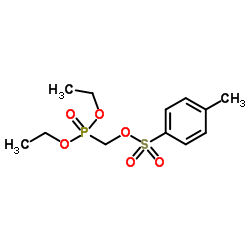
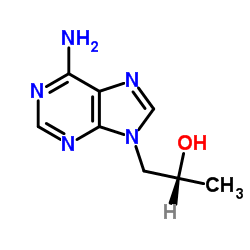
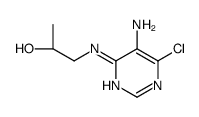
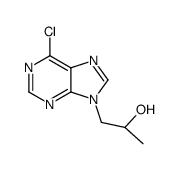

![(R)-9-[2-(2-tetrahydropyranyloxy)propyl]adenine structure](https://image.chemsrc.com/caspic/194/160616-02-4.png)
![N-[9-[(2R)-2-hydroxypropyl]purin-6-yl]benzamide structure](https://image.chemsrc.com/caspic/156/160616-03-5.png)


